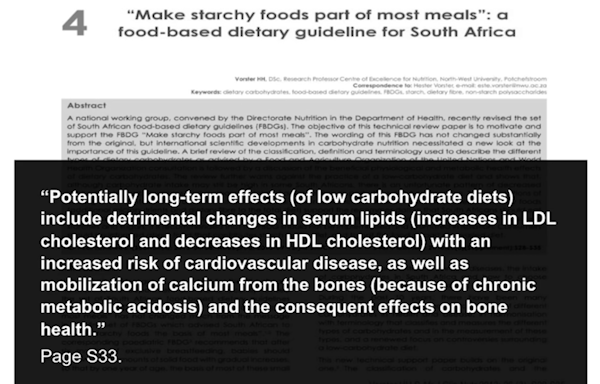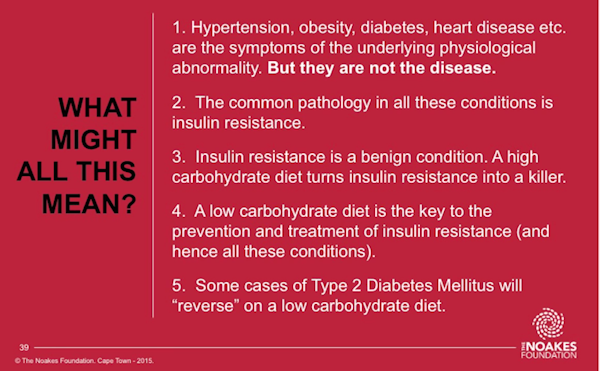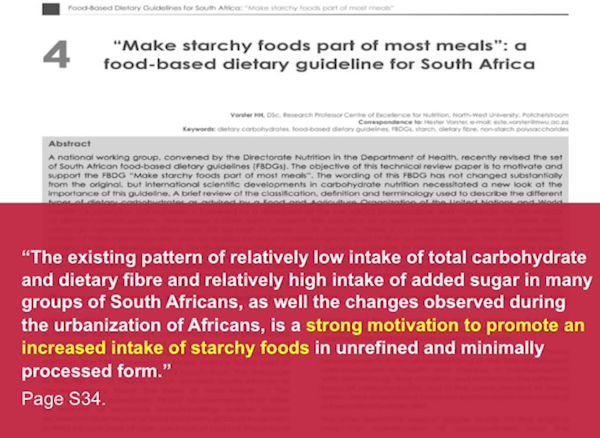South African Dietary Guidelines
(12 minutes)
Dr Tim Noakes giving a lecture on nutrition at his "trial."
Published by: CAPE TOWN LIVE - September, 2016
Prof. Hester Vorster, was primarily responsible for the South African Dietary Guidelines. They were developed with knowledge of South Africa's history of rural poverty and more recent migration to the city in mind. She thinks that there is a genetic distinction between the population of South Africa and the population of South-East Asia.
This is the key paper, published in 2013.

The main recommendation is that "South Africans should eat starchy foods in the form of minimally processed or whole grains, legumes and root vegetables, rather than as refined starches and sugars." And she did not recommend a low-carbohydrate diet. (above)
Prof. Noakes believes that the statement, "potential long term effects of a low-carbohydrate diet" increased the risk of cardio vascular disease, is wrong, although in 2013 the peer review of the paper didn't notice that error. (Note: This was a common view at the time, and Prof. Vorster and the peer reviewers were confirming what they knew.)

All of these non-communicable diseases are related, they occur in a cluster. A natural condition, insulin resistance which is protective of body cells, becomes chronic and intensifies if one eats a high carbohydrate diet over a long period. A low-carbohydrate diet reduces insulin resistance and all these conditions improve.

Prof. Hester H. Vorster
Here is a link to the abstract of the paper,  “Make starchy foods part of most meals”: A food-based dietary guideline for South Africa. by HH Vorster.
“Make starchy foods part of most meals”: A food-based dietary guideline for South Africa. by HH Vorster.

Prof. Vorster identifies the fact that the very poor quality food in rural areas was high in carbohydrates and high in fibre. As more people moved to the city the amount of highly processed carbohydrate in the diet increased as did the amount of sugar in the diet, especially sugary drinks.

The essential thinking behind the South African Dietary Guidelines is demonstrated above. Starchy, high-fibre carbohydrates are good and should be the basis of most meals. (In South Africa as in the USA, the cost of food is a key political and health problem, this food is cheap.) Dietary guidelines all around the world recommend eating plenty of fruits and vegetables. The guidelines assume that eating fat, makes you fat, a basic error caused by misunderstanding human physiology. (Confusing physics with biology.) So if the body is healthy, that low-fat high fibre diet can work well. But if insulin resistance becomes normal, then metabolic problems like obesity and Type II Diabetes will develop.
Although it was known over 100 years ago that Type II Diabetes could be controlled by starvation, or by eating a very-low carbohydrate diet, after the discovery of Insulin, that knowledge was lost in medical training. But by 2013 it was already recorded in the literature that low-carbohydrate diets could reverse Type II Diabetes, although there were no randomised controlled trials to demonstrate that yet.
Prof. Noakes says that we need to train our doctors better. That we need to go back to pre-history and look at what the first humans ate, and how they used their time.

He reminds us of the oldest skeletal remains found in South Africa, and the cave at Pinnacle point where early humans once lived. (below)


Prof. Noakes says that Prof. Vorster if correct in the excerpt above. In identifying that in modern times there has been a change in the diet that is causing chronic metabolic disease. When people have previously eaten a very poor quality diet in a rural area, and they come into the city, they continue to eat a low-cost diet, of even poorer quality, that leads to health problems.

Prof. Vorster says that although the rural diet was monotonous, it was cheap, and it was protective against the metabolic diseases we see in South African cities today.

Prof. Noakes claims that having identified obesity as a problem, Prof. Vorster clings to the idea that excess fat in the diet causes obesity. (Fat has 9 calories per gram and carbohydrates has 4 calories per gram. Therefore (wrongly) eating too much fat makes you fat.)
Note that when the diet changed, the amount of protein in the diet stayed relatively constant. That's a common finding in many studies. But the quality of the protein matters, and animal protein comes with important animal fats and the fat soluble vitamins that we all need.
